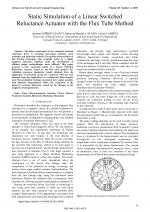| 2/2010 - 6 |
Static Simulation of a Linear Switched Reluctance Actuator with the Flux Tube MethodSANTO, A. E. |
| Extra paper information in |
| Click to see author's profile in |
| Download PDF |
Author keywords
electromagnetic analysis, linear motors, numerical analysis, reluctance machines, simulation
References keywords
reluctance(17), switched(16), motor(10), magnetics(8), flux(6), design(6), modeling(5), machines(4), electric(4)
Blue keywords are present in both the references section and the paper title.
About this article
Date of Publication: 2010-05-31
Volume 10, Issue 2, Year 2010, On page(s): 35 - 42
ISSN: 1582-7445, e-ISSN: 1844-7600
Digital Object Identifier: 10.4316/AECE.2010.02006
Web of Science Accession Number: 000280312600006
SCOPUS ID: 77954631444
Abstract
The linear counterpart of the rotational switched reluctance drive is receiving increasing attention from academic and industrial societies. The special characteristics of this driving technology, that normally works in a highly magnetic saturation regimen, make the development of efficient design methodologies more difficult. This paper proposes a new numerical model of a Linear Switched Reluctance Actuator based on the flux tube method. For validation purposes, simulation results obtained from the application of presented model are compared with the ones obtained from the application of a commercial finite element tool. The modulation technique proposed here makes possible, with minimal computational effort, the evaluation of the impact in actuator behaviour caused by the changes on the magnetic circuit geometries. |
| References | | | Cited By |
Web of Science® Times Cited: 2 [View]
View record in Web of Science® [View]
View Related Records® [View]
Updated today
SCOPUS® Times Cited: 5
View record in SCOPUS® [Free preview]
View citations in SCOPUS® [Free preview]
[1] Experimental Method of Determining the Equivalent Circuit Parameters of a Switched Reluctance Machine, VUKADINOVIC, D., GRBIN, S., BASIC, M., Advances in Electrical and Computer Engineering, ISSN 1582-7445, Issue 3, Volume 15, 2015.
Digital Object Identifier: 10.4316/AECE.2015.03013 [CrossRef] [Full text]
[2] Numerical Modal Analysis of Vibrations in a Three-Phase Linear Switched Reluctance Actuator, Salvado, José, Calado, Maria do Rosário, Santo, António Espírito, Guerman, Anna, Modelling and Simulation in Engineering, ISSN 1687-5591, Issue , 2017.
Digital Object Identifier: 10.1155/2017/3258376 [CrossRef]
[3] Analytical Modelling of a Hybrid Reluctance Motor Based on Magnetic Equivalent Circuit, Su, Xinyi, Yang, Xiaofeng, Xu, Yunlang, 2023 IEEE International Conference on Industrial Technology (ICIT), ISBN 979-8-3503-3650-4, 2023.
Digital Object Identifier: 10.1109/ICIT58465.2023.10143108 [CrossRef]
Disclaimer: All information displayed above was retrieved by using remote connections to respective databases. For the best user experience, we update all data by using background processes, and use caches in order to reduce the load on the servers we retrieve the information from. As we have no control on the availability of the database servers and sometimes the Internet connectivity may be affected, we do not guarantee the information is correct or complete. For the most accurate data, please always consult the database sites directly. Some external links require authentication or an institutional subscription.
Web of Science® is a registered trademark of Clarivate Analytics, Scopus® is a registered trademark of Elsevier B.V., other product names, company names, brand names, trademarks and logos are the property of their respective owners.
Faculty of Electrical Engineering and Computer Science
Stefan cel Mare University of Suceava, Romania
All rights reserved: Advances in Electrical and Computer Engineering is a registered trademark of the Stefan cel Mare University of Suceava. No part of this publication may be reproduced, stored in a retrieval system, photocopied, recorded or archived, without the written permission from the Editor. When authors submit their papers for publication, they agree that the copyright for their article be transferred to the Faculty of Electrical Engineering and Computer Science, Stefan cel Mare University of Suceava, Romania, if and only if the articles are accepted for publication. The copyright covers the exclusive rights to reproduce and distribute the article, including reprints and translations.
Permission for other use: The copyright owner's consent does not extend to copying for general distribution, for promotion, for creating new works, or for resale. Specific written permission must be obtained from the Editor for such copying. Direct linking to files hosted on this website is strictly prohibited.
Disclaimer: Whilst every effort is made by the publishers and editorial board to see that no inaccurate or misleading data, opinions or statements appear in this journal, they wish to make it clear that all information and opinions formulated in the articles, as well as linguistic accuracy, are the sole responsibility of the author.





